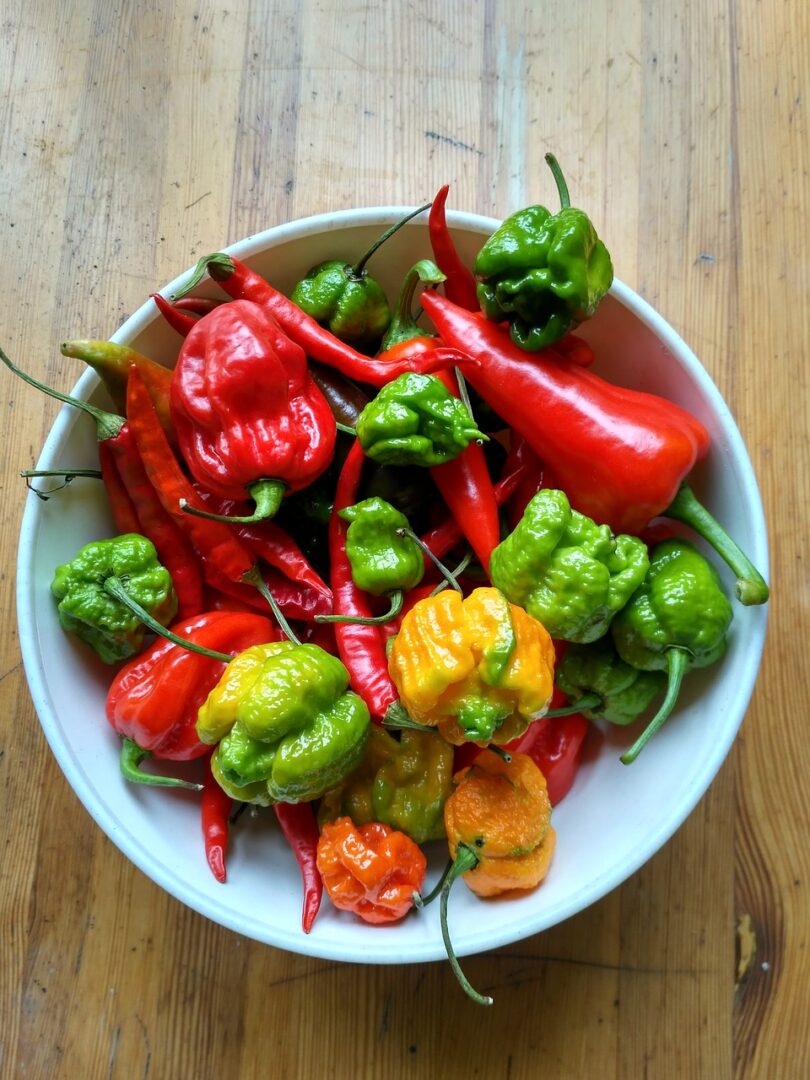There are so many peppers to choose from that it can be overwhelming to pick one. What are the differences?
Sweet peppers have a nice earthy flavor but no heat. Traditionally called green peppers or bell peppers, they usually mature to a totally different color. Green pepper is basically an unripe bell pepper. If you want a green pepper, pick it while it’s green. If allowed to stay on the plant long enough, the pepper will ripen to its mature color, usually red, yellow, orange or purple. This usually increases the sugar content.
Hot peppers or chili peppers are rated on what is called the Scoville Heat Scale (Scoville Heat Units). This measures the amount of capsaicin in the pepper—capsaicin is what makes a pepper hot. The higher the number, the hotter the pepper. The seeds and white membranes inside the pepper contain the most heat. If you remove those, you can tone it down a little.
If you’re shopping for peppers, here is a guide to some of the peppers we most often carry. Scoville Heat Units (SHU) are listed after each variety.
SWEET (BELL) PEPPERS (Zero SHU)
Bell Orange: A very sweet bell pepper that ripens to pretty orange fruits on productive plants.
Big Bertha: A disease resistant sweet bell pepper that ripens to red. Larger than usual for a pepper so staking is recommended.
California Wonder: The classic green bell pepper that ripens to red.
Golden Wonder: Nearly identical to California Wonder, Golden Wonder ripens to bright gold when ripe.
Keystone Resistant: Very similar to California Wonder but is resistant to Tobacco Mosaic Virus.
Purple Beauty: Thick-walled fruits on productive plants ripen to purple.
Red Beauty: Disease resistant plants with thick-walled fruits that ripen to red.
Sweet Banana: Long, crisp and sweet fruits ripen from yellow to red.
HOT PEPPERS
Anaheim Chili: On the mild side with 500 to 2500 SHU. The heat level can vary based on conditions. A hot dry summer can concentrate the heat levels some. Otherwise, use much like a Poblano.
Big Chili: A mildly hot Anaheim-type chili peppers. 500-2500 SHU
Cayenne: Spicy hot peppers on productive plants. Often dried and ground as a spice. 30,000 to 50,000 SHU
Ghost: So hot it’s used as an elephant repellent in India! 850,000 to 1,000,000 SHU. Currently ranked as the 7th hottest pepper according to pepperhead.com.
Habanero: Native to South American, Habaneros have a citrusy flavor—if you can get past the heat. 100,000-350,000 SHU
Jalapeno: Probably the best-known hot pepper. When smoked and dried, it is called Chipotle. 2500-8000 SHU
Pepperoncini: Used extensively in Italian cooking, Pepperoncini are very mild—often pickled. 100-500 SHU
Sweet Heat: Very mildly spicy and particularly sweet, it contains 65% more vitamin C than other peppers. It’s a very short attractive plant so is great in containers. 230-330 SHU
Tabasco: The pepper used by the McIlhenny family to make their famous hot sauce, it’s about as hot as cayenne. 30,000-50,000 SHU
Thai Dragon: Short bushy plants are both decorative and productive. 50,000-100,000 SHU
Tiburon Poblano: Taller than most peppers at 4 to 5 feet, it’s mildly spicy with a smoky note. When roasted and dried, it is called Ancho. 1000-2000 SHU. This is the one called Chili Rellenos when stuffed with cheese and served with a red Mexican-style sauce.
Trinidad Scorpion: this native to Trinidad and Tobago is currently ranked as the 2nd hottest pepper in the world by pepperhead.com. It ranks a mere 1.2 MILLION SHU!
We don’t carry it, but in case you’re curious, the hottest pepper currently is the Carolina Reaper. Developed by “Smokin’ Ed” Currie, owner of the Puckerbutt Pepper Company in Rock Hill, South Carolina. It ranks in with an average of 1.6 million SHU, with some individual peppers claiming as many as 2.2 SHU. There are several other peppers that claim to have higher SHU but none have been confirmed by the Guinness Book of World Records.
Remember, all peppers like full sun. They are related to tomatoes, so if you had a disease problem with tomatoes last year, keep peppers out of that area for the season. Peppers adapt well to growing in containers. Just be sure to use potting soil and keep fed with a good vegetable fertilizer. I use Espoma Organic’s Tomato-tone.
If you want to grow peppers this year or have any questions, come on by. The selection is great.


I love growing bell peppers, but they’re definitely not the easiest vegetable to grow!
They do take a while to obtain any size. The real secret to growing peppers is SUN and warm. A south window indoors is best for starters. Since they are native to near the equator, they love warm and sunny. I’ve been very successful growing them–but I’m blessed with lots of SUN–more than six hours of direct sun. I’ve never had any problems with them outside–but have noticed that they don’t produce as well during prolonged cloudy stretches. Are you having a particular problem?